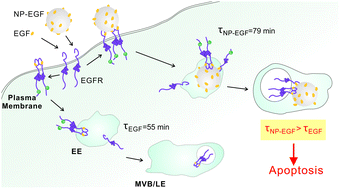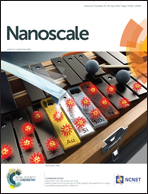Nanoconjugation prolongs endosomal signaling of the epidermal growth factor receptor and enhances apoptosis†
Abstract
It is becoming increasingly clear that intracellular signaling can be subject to strict spatial control. As the covalent attachment of a signaling ligand to a nanoparticle (NP) impacts ligand–receptor binding, uptake, and trafficking, nanoconjugation provides new opportunities for manipulating intracellular signaling in a controlled fashion. To establish the effect of nanoconjugation on epidermal growth factor (EGF) mediated signaling, we investigate here the intracellular fate of nanoconjugated EGF (NP-EGF) and its bound receptor (EGFR) by quantitative correlated darkfield/fluorescence microscopy and density-based endosomal fractionation. We demonstrate that nanoconjugation prolongs the dwell time of phosphorylated receptors in the early endosomes and that the retention of activated EGFR in the early endosomes is accompanied by an EGF mediated apoptosis at effective concentrations that do not induce apoptosis in the case of free EGF. Overall, these findings indicate nanoconjugation as a rational strategy for modifying signaling that acts by modulating the temporo-spatial distribution of the activated EGF-EGFR ligand–receptor complex.


 Please wait while we load your content...
Please wait while we load your content...